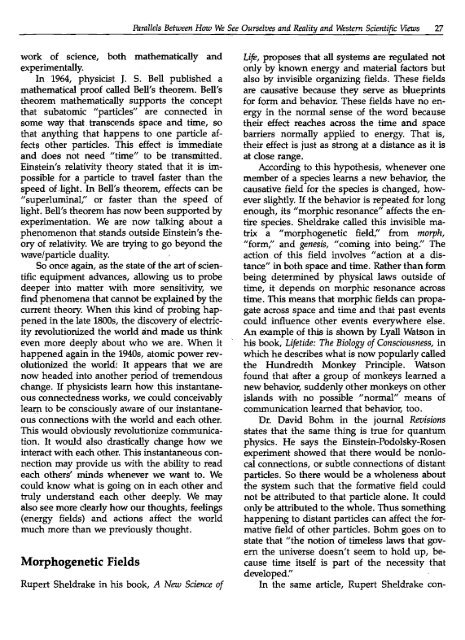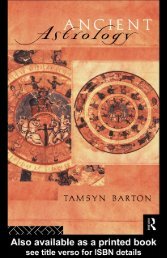Hands of Light – Guide to Healing - Soul Circles
Hands of Light – Guide to Healing - Soul Circles
Hands of Light – Guide to Healing - Soul Circles
Create successful ePaper yourself
Turn your PDF publications into a flip-book with our unique Google optimized e-Paper software.
work <strong>of</strong> science, both mathematically and<br />
experimentally<br />
In 1964, physicist J. S. Bell published a<br />
mathematical pro<strong>of</strong> called Bell's theorem. Bell's<br />
theorem mathematically supports the concept<br />
that suba<strong>to</strong>mic "particles" are connected in<br />
some way that transcends space and time, so<br />
that anything that happens <strong>to</strong> one particle affects<br />
other particles. This effect is immediate<br />
and does not need "time" <strong>to</strong> be transmitted.<br />
Einstein's relativity theory stated that it is impossible<br />
for a particle <strong>to</strong> travel faster than the<br />
speed <strong>of</strong> light. In Bell's theorem, effects can be<br />
"superluminal," or faster than the speed <strong>of</strong><br />
light. Bell's theorem has now been supported by<br />
experimentation. We are now talking about a<br />
phenomenon that, stands outside Einstein's theory<br />
<strong>of</strong> relativity. We are trying <strong>to</strong> go beyond the<br />
wave/particle duality.<br />
So once again, as the state <strong>of</strong> the art <strong>of</strong> scientific<br />
equipment advances, allowing us <strong>to</strong> probe<br />
deeper in<strong>to</strong> matter with more sensitivity, we<br />
find phenomena that cannot be explained by the<br />
current theory. When this kind <strong>of</strong> probing happened<br />
in the late 1800s, the discovery <strong>of</strong> electricity<br />
revolutionized the world and made us think<br />
even more deeply about who we are. When it<br />
happened again in the 1940s, a<strong>to</strong>mic power revolutionized<br />
the worlds It appears that we are<br />
now headed in<strong>to</strong> another period <strong>of</strong> tremendous<br />
change. If physicists learn how this instantaneous<br />
connectedness works, we could conceivably<br />
learn <strong>to</strong> be consciously aware <strong>of</strong> our instantaneous<br />
connections with the world and each other.<br />
This would obviously revolutionize communication.<br />
It would also drastically change how we<br />
interact with each other. This instantaneous connection<br />
may provide us with the ability <strong>to</strong> read<br />
each others' minds whenever we want <strong>to</strong>. We<br />
could know what is going on in each other and<br />
truly understand each other deeply. We may<br />
also see more clearly how our thoughts, feelings<br />
(energy fields) and actions affect the world<br />
much more than we previously thought.<br />
Morphogenetic Fields<br />
Rupert Sheldrake in his book, A New Science <strong>of</strong><br />
Parallels Between Haw We See Ourselves and Reality and Western Scientific Views 27<br />
Life, proposes that all systems are regulated not<br />
only by known energy and material fac<strong>to</strong>rs but<br />
also by invisible organizing fields. These fields<br />
are causative because they serve as blueprints<br />
for form and behavior. These fields have no energy<br />
in the normal sense <strong>of</strong> the word because<br />
their effect reaches across the time and space<br />
barriers normally applied <strong>to</strong> energy. That is,<br />
their effect is just as strong at a distance as it is<br />
at close range.<br />
According <strong>to</strong> this hypothesis, whenever one<br />
member <strong>of</strong> a species learns a new behavior, the<br />
causative field for the species is changed, however<br />
slightly. If the behavior is repeated for long<br />
enough, its "morphic resonance" affects the entire<br />
species. Sheldrake called this invisible matrix<br />
a "morphogenetic field," from morph,<br />
"form," and genesis, "coming in<strong>to</strong> being." The<br />
action <strong>of</strong> this field involves "action at a distance"<br />
in both space and time. Rather than form<br />
being determined by physical laws outside <strong>of</strong><br />
time, it depends on morphic resonance across<br />
time. This means that morphic fields can propagate<br />
across space and time and that past events<br />
could influence other events everywhere else.<br />
An example <strong>of</strong> this is shown by Lyall Watson in<br />
his book, Lifetide: The Biology <strong>of</strong> Consciousness, in<br />
which he describes what is now popularly called<br />
the Hundredth Monkey Principle. Watson<br />
found that after a group <strong>of</strong> monkeys learned a<br />
new behavior, suddenly other monkeys on other<br />
islands with no possible "normal" means <strong>of</strong><br />
communication learned that behavior, <strong>to</strong>o.<br />
Dr. David Bohm in the journal Revisions<br />
states that the same thing is true for quantum<br />
physics. He says the Einstein-Podolsky-Rosen<br />
experiment showed that there would be nonlocal<br />
connections, or subtle connections <strong>of</strong> distant<br />
particles. So there would be a wholeness about<br />
the system such that the formative field could<br />
not be attributed <strong>to</strong> that particle alone. It could<br />
only be attributed <strong>to</strong> the whole. Thus something<br />
happening <strong>to</strong> distant particles can affect the formative<br />
field <strong>of</strong> other particles. Bohm goes on <strong>to</strong><br />
state that "the notion <strong>of</strong> timeless laws that govern<br />
the universe doesn't seem <strong>to</strong> hold up, because<br />
time itself is part <strong>of</strong> the necessity that<br />
developed."<br />
In the same article, Rupert Sheldrake con-




